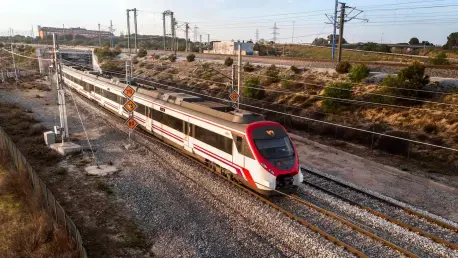In the ever-evolving landscape of public transportation, Rohit Laila stands as a beacon of knowledge and experience. With a career spanning decades in logistics and a fervent passion for innovation, he’s uniquely positioned to provide insights into Seattle’s ambitious transit projects. Today, we’ll delve into the implications and foresights surrounding the Federal Way Link Extension and the East Link Crosslake Connection.
Can you elaborate on the Federal Way Link Extension and its importance to the Seattle metropolitan area?
The Federal Way Link Extension is a crucial project for Seattle’s transit network. It aims to extend light rail service approximately eight miles southward, enhancing connectivity for the region. This extension is pivotal as it helps alleviate traffic congestion, improves accessibility to jobs and housing, and encourages sustainable commuting in the Puget Sound area.
What are the main features of the Federal Way Link Extension?
The extension will introduce three new stations—Kent Des Moines, Star Lake, and Downtown Federal Way. It covers a roughly eight-mile stretch that will significantly enhance the region’s public transit infrastructure. The development focuses on improving access and reducing travel times for commuters, contributing to a more integrated and efficient transit system.
Why was the decision made to aim for an early opening in winter 2025?
Opting for an early opening is primarily driven by the progress seen in system integration testing, which is close to completion, and the broader objective to offer improved transit options sooner. Advancing the opening reflects a proactive approach in response to current progress, allowing the public to benefit from the extended services ahead of schedule.
How significant is the system integration testing in the project, and is it on schedule?
System integration testing ensures that all components of the light rail system work seamlessly together before launching the extension. This phase is crucial for confirming operational readiness and safety. As of now, the testing is nearing its end, keeping the project on track for its proposed opening timeline.
How does the Federal Way Link Extension contribute to connecting Pierce County with the broader Puget Sound region?
By extending the light rail network further south, the project effectively links Pierce County with vital urban centers across the Puget Sound region. This enhances regional connectivity, allowing residents and workers easy access to a wider array of opportunities for employment, education, and leisure, fostering economic growth.
What are the ongoing efforts for the East Link Crosslake Connection, and when is its expected completion date?
Work on the East Link Crosslake Connection remains vigorous, with a target completion date set for early 2026. This crucial link will bridge East King County with Seattle, broadening the 2 Line’s reach and ensuring a more cohesive transit experience across the city.
Can you explain how the East Link Crosslake Connection will impact the overall transit network in King County?
The East Link Crosslake Connection will significantly enhance transit accessibility between the Eastside communities and downtown Seattle. This integration with the existing network will promote easier and more efficient travel, reducing road congestion and improving the overall reliability of public transit across King County.
How has the Sound Transit Board managed to resequence the opening dates of these projects?
The Sound Transit Board has adopted a dynamic approach by assessing real-time project progress and readiness. They’ve been agile in their planning, allowing them to modify timelines in response to the actual development status, thereby ensuring resources are optimally used to meet public needs efficiently.
Could you discuss the challenges you faced in project management and how you overcame them?
Managing such large-scale transit projects inevitably involves challenges like funding, scheduling, and coordination among numerous stakeholders. By employing rigorous planning, stakeholder engagement, and leveraging innovative technology, we’ve been able to address these issues effectively, ensuring that projects stay on track and within budget.
What impact do you expect the Federal Way Link Extension to have on local commuting patterns and the economy?
The extension is poised to significantly alter commuting behaviors by offering a reliable alternative to road travel. Economically, it will attract businesses to relocate nearer to transit locations, stimulate mixed-use development, and support job creation, thereby fostering robust economic activity in the areas it serves.
How does the planned alignment of the extension, which primarily follows an elevated path, affect construction and operations?
An elevated alignment helps minimize environmental impact and land use conflicts, while also ensuring quick and efficient construction. Operationally, it offers uninterrupted service unaffected by surface traffic issues, thus enhancing service reliability and safety for passengers.
Once completed, how will the 2 Line integrate with other transit lines, such as the 1 Line?
Upon completion, the 2 Line will run between the Eastside and downtown Seattle, linking seamlessly with the 1 Line at the International District/Chinatown Station. This integration will create a fluid transit network, offering passengers convenient transfers and expanded travel options across the region.
What measures are in place to ensure efficient operations once the extension opens?
We have implemented advanced signaling systems and rigorous staff training programs to enhance operational efficiency. Continuous monitoring and maintenance plans have been developed to ensure safety and reliability. These efforts will collectively maintain high service standards for passengers.
How does the development of the Federal Way Link Extension compare to transit advancements in other U.S. cities?
Seattle’s proactive approach mirrors national trends towards expanding urban transit networks to enhance connectivity, reduce emissions, and create sustainable commuting options. Our focus on state-of-the-art technology and strategic planning aligns with best practices in leading U.S. cities.
Is there anything specific passengers should look forward to with the new stations at Kent Des Moines, Star Lake, and Downtown Federal Way?
Passengers can anticipate modern, accessible station designs with amenities that enhance convenience and comfort. These stations will be hubs of activity, contributing to vibrant transit-oriented developments in their respective areas, creating dynamic community spaces.
How will Sound Transit continue to update and communicate with the public as these projects progress?
Sound Transit is committed to transparency and engagement. We will continue to provide regular updates through multiple channels, including public meetings, social media, and our website, ensuring stakeholders stay informed and involved as the projects near completion.
What is your forecast for the future landscape of public transit in Seattle and surrounding regions?
Looking ahead, public transit in Seattle is set to expand and innovate continuously, further integrating technological advancements and sustainable practices. We anticipate increased ridership as the network becomes more comprehensive and efficient, significantly contributing to the region’s economic and environmental goals.









